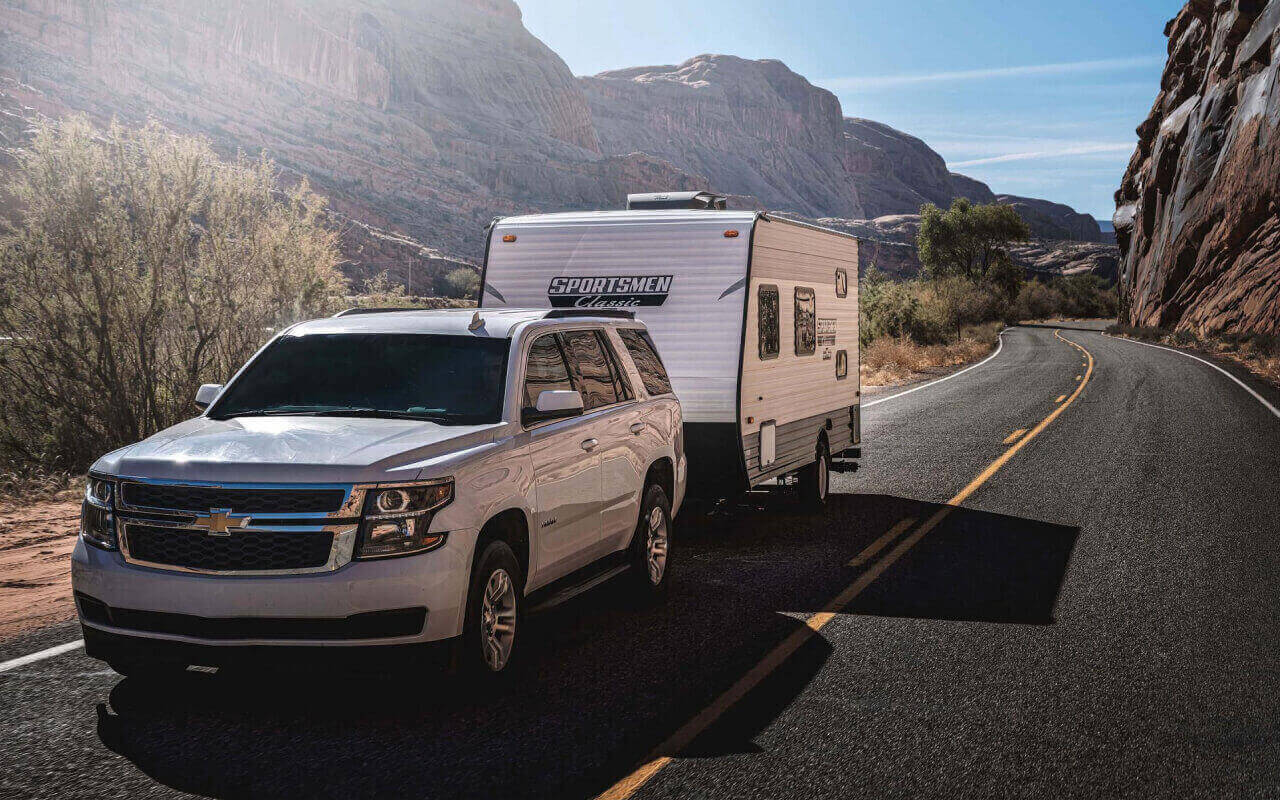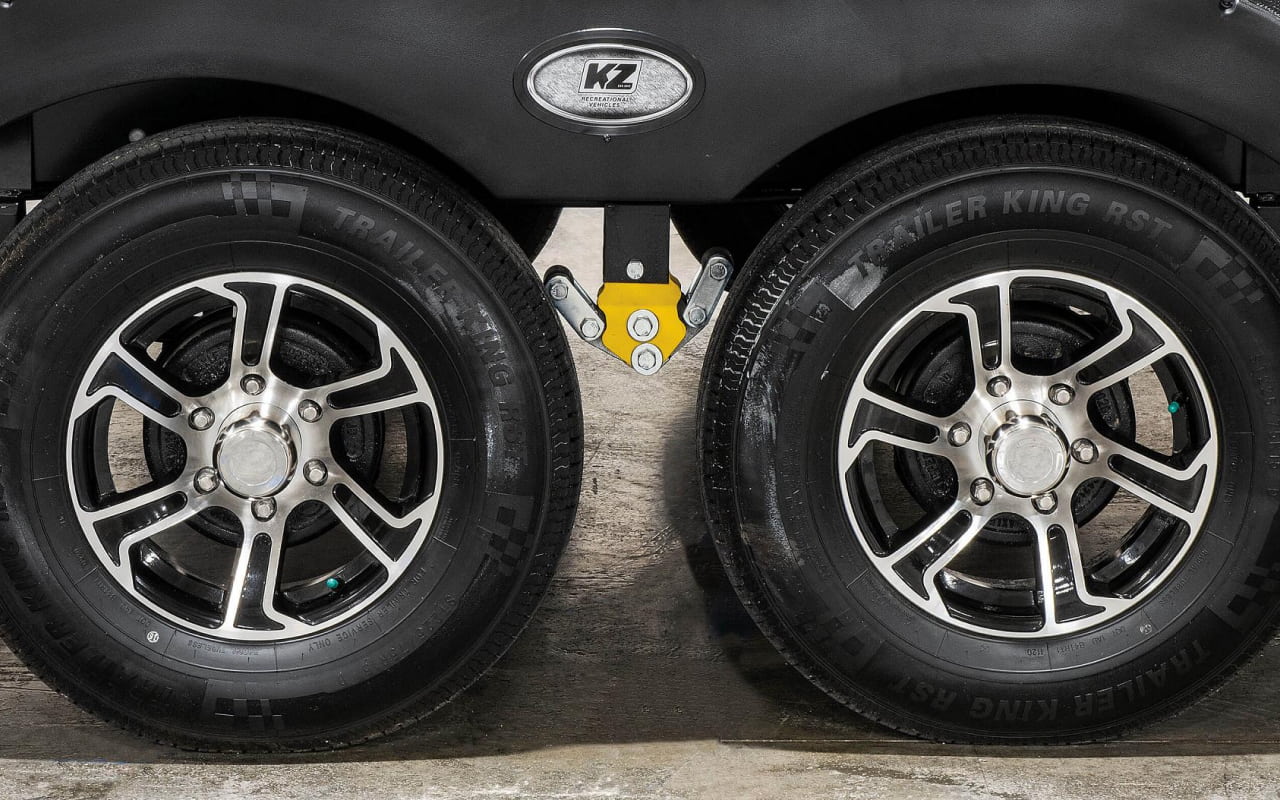
RVing is a great way to see the world, and some of that journey involves driving to your desired destination. While on the road, you want to make sure that any vehicles or trailers you’re bringing along can be safely towed. In the world of camping, there are two types of towing capacities to consider. For the motorhome owners on the road, there’s the towing capacity of what their motorhome can safely tow behind it. For RVers with a towable unit like a fifth wheel, pop-up camper, or other RV types, towing capacity is focused on what the towing vehicle can safely pull.
Both types of RV towing require a little extra planning before you hitch up and hit the road. It’s important to ensure that the vehicle being towed has its weight properly balanced and that you’ve practiced the towing setup before embarking on your journey. If you’re ready to RV like a pro, learn more about RV towing below!
Motorhome Towing Capacity Considerations
Many motorhome RVers choose to bring a smaller vehicle along for the ride to use when the rig is set up for camping. The smaller vehicle towed behind a motorhome is often known as a toad or dinghy. You can visit our RV glossary to learn more about these terms.
When towing a smaller vehicle behind your motorhome, it’s important to understand your towing capacity limits. Many motorhomes can safely tow small passenger vehicles or light trailer beds with motorcycles or other vehicles. Before attaching your car to your motorhome, review the owner’s manuals for your car and for your motorhome to ensure the car can be safely towed. You’ll want to check your RV’s gross combination weight (GCWR) to ensure that the total weight of your motorhome, towing vehicle, and any towing support features can all be safely pulled by the RV’s engine.
Additionally, you’ll want to review your dinghy’s towing needs. There are three common ways to tow a passenger vehicle behind a motorhome, and these include:
- Flat towing. Some passenger vehicles can be towed on all four wheels, which is also known as flat towing for four down. Typically, four-wheel-drive vehicles are the best fit for this type of towing, but there are several subcompact cars that are also suitable. In this setup, the dinghy is most commonly connected to the motorhome with a tow bar.
- Tow dolly. Front-wheel drive vehicles are generally not capable of flat towing, so additional support is needed for towing these types of vehicles. Many RVers use a tow dolly, which is a system in which a front-wheel-drive vehicle’s front tires are hooked into the dolly, and the rear wheels touch the road. Breaking needs are a consideration with this type of passenger vehicle towing to ensure added safety. With this towing setup, the dinghy is connected to the dolly which is then connected to the motorhome.
- Car trailer. With this type of RV towing, your passenger vehicle is fully loaded on a small trailer and there is no passenger vehicle contact with the road. This is often the heaviest towing consideration as there is the weight of the passenger vehicle and the car hauler. Still, it is a popular option for RVers who do not have a dinghy that’s capable of being safely towed with the other methods. With this towing method, the car sits atop a trailer that is connected to the motorhome.
When choosing your motorhome dinghy towing type, you’ll need to keep the towing capacity of your rig in mind. While Class A diesel motorhomes can often support a car trailer setup, smaller RVs like Class C motorhomes may require a lighter towing setup. Class B motorhomes often have unique needs for towing smaller vehicles. Check your owner’s manual to learn more about your RV’s towing capacity.
Vehicle RV Towing Capacities for Towable Units
While motorhome drivers have to consider what type of dinghy they can tow behind their rig, RVers with towable setups have a different need when considering their towing capacities. Things are reversed, and RVers must consider their towing vehicle’s capabilities for pulling weight. Additionally, they must consider the weight distribution of the load they’ll be bringing to ensure easy towing.
Pickup trucks are the most common type of passenger vehicle used for towing an RV due to the load-carrying capacity these vehicles already include. Many trucks are able to safely carry high weights and this capability can be translated into RV towing capacity when the weight is properly distributed on the truck. For example, some towable RVs are attached not to the hitch, but to systems installed in a truck bed that distribute the rig’s weight similarly to a full truck bed.
Whether you’re towing an RV that hooks up at the rear of the truck or a setup where the truck bed is being utilized for towing, you need to understand your towing vehicle’s weight capacity. This isn’t just for trucks, even sedans that are towing a smaller RV need to have the right weight capacity. Check your towing vehicle’s owner’s manual to learn more about its towing capabilities, requirements, and limits. When in doubt, ask an RV expert for some guidance. If you’re determined to keep your current towing passenger vehicle, you’ll need to choose RVs for sale that are well below your passenger vehicle’s towing capacity limits.
In addition, you need to keep your gross vehicle weight rating (GVWR) in mind when towing an RV. The gross axle weight rating (GAWR) and the tongue weight are also important to ensure that you’re properly towing the right amount of weight.
The tongue weight is just as important as all other RV towing capacity considerations as it’s the connection point for the weight the trailer tongue puts on your tow hitch. For heavier tows, a weight distribution system is key to ensure that the towing vehicle can properly pull the load. This means that the hitch you choose for towing your RV is just as important as the choices you make for RV type and towing vehicle.
The most popular towable RV hitch types include:
- Receiver hitch. This is a common hitch type that uses a square receiver tube to secure the towed item. This towing hitch type is typically for lighter loads and does not support larger towable RVs.
- 5th wheel hitch. This hitch system is popular for 5th wheel RVs and is mounted in your pickup truck bed. This mounting system distributes the RV’s weight directly over your towing truck, which can offer more stability and easier towing. It allows for higher weight capacities to be securely towed and also offers a smoother ride.
- Weight distribution hitch. Used for bumper pull RVs, this hitch type is ideal for distributing the weight of the load throughout your RV and towing passenger vehicle wheels. This is often used for heaver RVs that are near the maximum passenger vehicle towing capacity for easier towing.
When towing any type of RV behind your passenger vehicle, make sure to keep safety in mind. Many RVs include braking systems, signal connections, cameras, and additional features that help improve safety. Experts also recommend extending your towing vehicle’s side-view and rear-view mirrors to ensure full visibility beyond the RV that you’re towing. Visit your local Lazydays RV dealership to learn more about weight capacities and best practices for towing.




